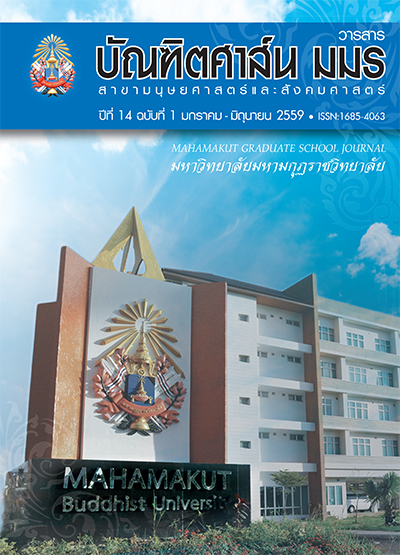การศึกษาเชิงวิเคราะห์การแก้ไขปัญหาสัทธรรมปฏิรูป ในพุทธศาสนาด้วยพุทธวจนะ
บทคัดย่อ
วิทยานิพนธ์เรื่อง “การศึกษาเชิงวิเคราะห์เรื่อง การศึกษาเชิงวิเคราะห์การแก้ไขปัญหาสัทธรรม ปฏิรูปในพุทธศาสนาด้วยพุทธวจนะ” เป็นการศึกษา เชิงคุณภาพ (Qualitative study) แบบวิจัยเอกสาร (Documentary Research) โดยมีจุดประสงค์ใน การวิจัย ดังนี้ 1) เพื่อศึกษาสัทธรรมปฏิรูปในพุทธ ศาสนา 2) เพื่อศึกษาการแก้ปัญหาสัทธรรมปฏิรูป ในพุทธศาสนาด้วยพุทธวจนะ และ 3) เพื่อวิเคราะห์ การแก้ปัญหาสัทธรรมปฏิรูปในพุทธศาสนาด้วย พุทธวจนะ
จากผลการวิจัย พบว่า
1. สัทธรรมปฏิรูปในพุทธศาสนา เป็นส่วน ของธรรมปลอม เป็นทางแห่งความชั่ว สาเหตุของ สัทธรรมปฏิรูปเกิดจากความประมาท 4 ประการ คือ 1) พยัญชนะและอรรถะวิบัติ 2) ภิกษุเป็นผู้ว่ายาก สอนยาก 3) ภิกษุผู้เป็นพหูสูตขาดการถ่ายทอดพระ สัทธรรมที่ถูกต้อง และ 4) ภิกษุทั้งหลายผู้เป็นพระ เถระประพฤติตัวเป็นผู้มักมาก
2. การแก้ปัญหาสัทธรรมปฏิรูปในพุทธศาสนา ด้วยพุทธวจนะ อาศัยหลักคิดที่สำคัญ 3 เรื่องคือ 1. หลักคิดในหลักมหาปเทสสี่ 2. หลักคิดในกาลามสูตร 3. หลักคิดในสังขิตตสูตร หลักคิดทั้ง 3 ประการนี้ เป็นหลักคิดที่นำไปสู่การพัฒนาคุณภาพชีวิต คือ การละความชั่วทั้งทางกาย วาจา และใจ ประกอบ คุณงามความดี และรักษาคุณงามความดีนั้นไม่ให้ เสื่อม ตลอดทั้งพัฒนาความดีให้สูงยิ่งๆ ขึ้นไปหรือ ขัดเกลาจิตใจให้สะอาด บริสุทธิ์ เป็นไปเพื่อประโยชน์ ตน ประโยชนผ์ ูอื้่นและประโยชนส์ ุขของสังคมโดยรวม ซึ่งมีเป้าหมายสูงสุดคือ ความพ้นจากกองทุกข์ทั้งปวง
3. วิเคราะห์การแก้ปัญหาสัทธรรมปฏิรูปใน พุทธศาสนาด้วยพุทธวจนะ พบว่า พระพุทธเจ้าทรง ประทานพระวจนะไว้ว่าต้องแก้ด้วยหลักมหาปเทส 4 เป็นหลัก นอกจากนี้ เกณฑ์ที่ช่วยวินิจฉัยตรวจสอบ เพิ่มเติมเพื่อให้เกิดความมั่นใจมากขึ้นและส่งเสริม หลักมหาปเทส 4 ให้เกิดประสิทธิภาพมากยิ่งขึ้นก็คือ หลักกาลามสูตรและหลักสังขิตตสูตร หลักธรรมเหล่า นี้เป็นเสมือนเกณฑ์เสริมให้กับหลักมหาปเทส 4 ซึ่ง เป็นเกณฑ์หลักสำหรับการตรวจสอบ หรือวินิจฉัย ความถูกต้องแห่งสัทธรรมของพุทธศาสนา
เอกสารอ้างอิง
ข้อมูลปฐมภูมิ
การศาสนา, กรม. พระไตรปิฎกภาษาไทย ฉบับหลวง เล่มที่ 1, 2, 3, 4, 5, 8, 10, 11, 12, 13, 15, 16, 19, 20, 21, 23, 25, 31, และ 35 . กรุงเทพฯ: โรงพิมพ์การศาสนา, 2525.
ข้อมูลทุติยภูมิ
1) หนังสือ
พระพรหมคุณาภรณ์ (ป.อ. ปยุตฺโต). (2552ก). พจนานุกรมพุทธศาสตร์ ฉบับประมวลธรรม. (พิมพ์ครั้งที่ 12). กรุงเทพฯ: สานักพิมพ์จันทร์เพ็ญ.
_______. (2552ข). พจนานุกรมพุทธศาสน์ ฉบับประมวลศัพท์. (พิมพ์ครั้งที่ 17). กรุงเทพฯ: สานักพิมพ์จันทร์เพ็ญ.พุทธทาสภิกขุ. (2534). ตามรอยพระอรหันต์. กรุงเทพฯ: สุขภาพใจ.
ราชบัณฑิตยสถาน (2540). พจนานุกรมศัพท์ปรัชญาอังกฤษ - ไทย ฉบับราชบัณฑิตยสถาน. (พิมพ์ครั้งที่ 2). กรุงเทพฯ:อรุณการพิมพ์.
สมเด็จพระมหาสมณเจ้ากรมพระยาวชิรญาณวโรรส. (2544). นวโกวาท (ฉบับประชาชน). (พิมพ์ครั้งที่ 13). กรุงเทพฯ:โรงพิมพ์มามกุฏราชวิทยาลัย.
เสฐียรพงษ์ วรรณปก. (2543). คำบรรยายพระไตรปิฎก. กรุงเทพฯ: ธรรมสภา.
พระธรรมธีรราชมหามุนี (โชดก ญญาณสิทฺธิ). (2539). อุดมวิชา. กรุงเทพฯ
พุทธทาสภิกขุ. (ม.ป.ป.). ลัทธิความเป็นมาแห่งศาสนาหินยาน มหายาน. กรุงเทพฯ: ธรรมสภา.
อาสภเถร ปธานกัมมัฏฐานาจริยะ, พระอาจารย์. (2526). วิปัสสนาทีปนีฎีกา. กรุงเทพฯ: สร้างเป็นมังคลานุสรณ์ในงานฉลองชนมายุ 80 ปี เจ้าคุณพระพิมลธรรม อาสภมหาเถร เจ้าอาวาสวัดมหาธาตุยุวราชรังสฤษฏ์.
อำนวย ยัสโยธา. (2547). กาลามสูตร พระสูตรว่าด้วยความเชื่อแบบพุทธกับการดำเนินชีวิตประจำวัน ยุคข้อมูลข่าวสารครองโลก. กรุงเทพฯ: ภาพพิมพ์.
วัชระ งามจิตเจริญ (2552) พุทธศาสนาเถรวาท กรุงเทพฯ สำนักพิมพ์มหาวิทยาลัยธรรมศาสตร์.
Hospers, John. (1967). An Introduction to philosophical Analysis. 2 nd. ed. New Delhi : Prentice-Hall of India Private Ltd.
2) วิทยานิพนธ์/สารนิพนธ์
นิกิจ พลายชุม. (2523). “วิเคราะห์วรรณกรรมของพุทธทาสภิกขุ”. ปริญญานิพนธ์การศึกษามหาบัณฑิต. กรุงเทพฯ:มหาวิทยาลัยศรีนครินทรวิโรฒประสานมิตร.
เมธา หริมเทพาธิป. (2557). “เกณฑ์ตัดสินความจริงตามหลักกาลามสูตร : การศึกษาเชิงวิเคราะห์ วิจักษ์ และวิธาน”.ปรัชญาดุษฎีบัณฑิต. บัณฑิตวิทยาลัย : มหาวิทยาลัยราชภัฎสวนสุนันทา.
อภิญญา เฟื่องฟูสกุล. (2540). “ศาสนทัศน์ของชุมชนเมืองสมัยใหม่ : ศึกษากรณีวัดพระธรรมกาย”. พุทธศาสน์ศึกษามหาบัณฑิต. กรุงเทพฯ: จุฬาลงกรณ์มหาวิทยาลัย.
อำนวย ยัสโยธา. (2543). “ภูมิปัญญาการนาทางสู่เนื้อธรรมของท่านพุทธทาส”. รายงานวิจัย. กรุงเทพฯ: สานักงานกองทุนสนับสนุนการวิจัย.
นวชัย เกียรติก่อเกื้อ. (2544). “การประเมินการตีความตัวบทตามแนวทางพุทธศาสนาเถรวาท”. ปริญญาอักษรศาสตรมหาบัณฑิต. กรุงเทพฯ: จุฬาลงกรณ์มหาวิทยาลัย.
ดาวน์โหลด
เผยแพร่แล้ว
รูปแบบการอ้างอิง
ฉบับ
ประเภทบทความ
สัญญาอนุญาต
บทความวิชาการและบทความวิจัยในวารสารฉบับนี้ถือเป็นความรับผิดชอบของผู้เขียนเท่านั้น บทความที่ได้รับการตีพิมพ์ในวารสารบัณฑิตศาส์น ถือเป็นลิขสิทธิ์ของมหาวิทยาลัยมหามกุฏราชวิทยาลัย ตามพระราชบัญญัติลิขสิทธิ์



